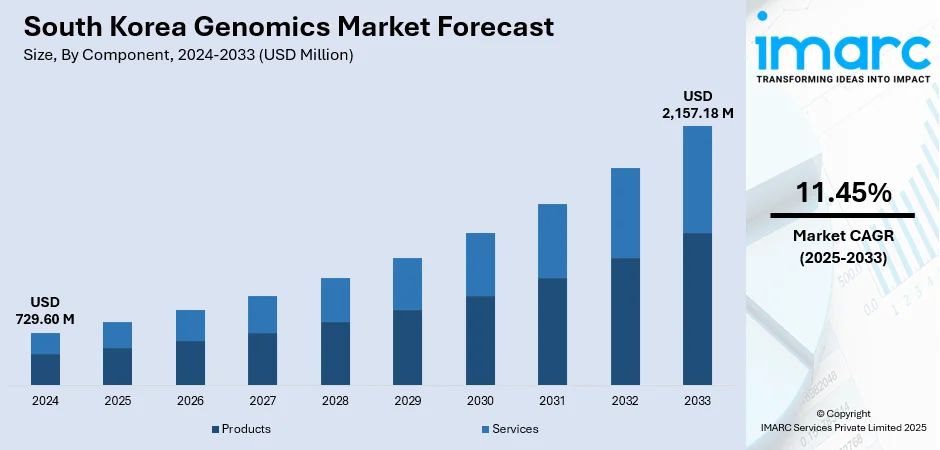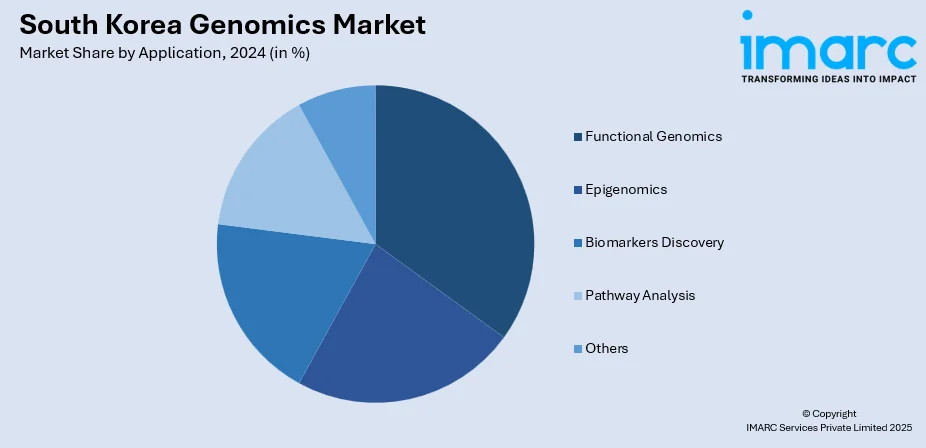
South Korea Genomics Market Size, Share, Trends and Forecast by Component, Application, Technology, End User, and Region, 2025-2033
South Korea Genomics Market Overview:
The South Korea genomics market size reached USD 729.60 Million in 2024. The market is projected to reach USD 2,157.18 Million by 2033, exhibiting a growth rate (CAGR) of 11.45% during 2025-2033. The market is advancing rapidly, driven by strong government support, technological innovation, and a growing emphasis on personalized medicine. The market encompasses diverse technologies such as sequencing, PCR, microarrays serving applications like drug discovery, clinical diagnostics, genetic testing, and biomarker discovery. These dynamics are shaping a robust industry positioned for global influence in South Korea genomics market share.
|
Report Attribute
|
Key Statistics
|
|---|---|
|
Base Year
|
2024
|
|
Forecast Years
|
2025-2033
|
|
Historical Years
|
2019-2024
|
| Market Size in 2024 | USD 729.60 Million |
| Market Forecast in 2033 | USD 2,157.18 Million |
| Market Growth Rate 2025-2033 | 11.45% |
South Korea Genomics Market Trends:
Enhanced National Sequencing Infrastructure
In June 2025, South Korea launched a nationwide genomics sequencing network through its National Genome Initiative, connecting six regional centers equipped with high-throughput sequencers. This network aims to significantly improve turnaround times for genetic testing and epidemiological surveillance. By linking public health labs with research institutions, the initiative promotes secure data-sharing protocols and standardized analysis pipelines leading to more timely responses to emerging infectious diseases. Additionally, integration with university medical centers ensures that genomic data informs both diagnostic and treatment decisions in real time. This system-level upgrade reflects growing operational maturity and demonstrates a clear path from data generation to clinical application. As regional hubs become more interconnected, redundancy reduces and capacity rises, yielding a more resilient genomics infrastructure. Through this strategic rollout, South Korea is enhancing its foundational capabilities and creating a more streamlined environment for both public health and life sciences research. These developments provide robust backing for future advances, reinforcing the long-term trajectory of South Korea genomics market growth.

To get more information on this market, Request Sample
Clinical Genomics Adoption in Healthcare
South Korea’s Ministry of Health reported in March 2025 that more than ten thousand patients received clinical genome sequencing through the national health insurance system last year. This implementation supports not only diagnostics for rare and inherited diseases but also pharmacogenomic testing to optimize medication regimens. By including these services in reimbursement, the government has made clinical genomics more accessible across both urban and regional hospitals. Training programs for healthcare professionals ensure genomic results are interpreted and applied effectively in patient care. As clinicians increasingly incorporate genomic insights into oncology, cardiovascular, and rare disease treatment pathways, patient outcomes are improving through more personalized, data-driven approaches. This shift also signals economic benefit, as broader adoption encourages further investment in sequencing infrastructure and analytics. With sustained integration into standard care workflows, South Korea is positioning itself national healthcare systems more precisely and cost-effectively. This rapid uptake affirms the ongoing momentum of South Korea genomics market trends.
Expansion of Genomic Data Integration
South Korea's national biobank in early 2024 reported that its genomic repository had broken through the 500,000 sequenced samples benchmark with robust representation across the country's diverse population groups. This growing dataset is powering new discoveries about genetic patterns of disease susceptibility, response to treatments, and population-specific risk factors. As genome-phenome associations become larger, scientists are creating increasingly accurate risk prediction models for long-term and hereditary diseases with increased ability to stratify patient groups. What makes South Korea's effort unique is the integration of the biobank with electronic health records, enabling longitudinal studies that can follow genomic markers over time and across clinical endpoints. This integration of scale, depth, and connectivity underpins broad applications in predictive healthcare, personalized medicine, and the development of drugs. Ethical governance architectures keep data use in check while facilitating multi-institutional research collaboration. These combined capabilities are empowering scientists with the capabilities to drive diagnostics and biomarker discovery on a national scale.
South Korea Genomics Market Segmentation:
IMARC Group provides an analysis of the key trends in each segment of the market, along with forecasts at the country and regional levels for 2025-2033. Our report has categorized the market based on component, application, technology, and end user.
Component Insights:
- Products
- Instruments and Software
- Consumables and Reagents
- Services
- Core Genomics Services
- NGS-Based Services
- Biomarker Translation Services
- Computational Services
- Others
The report has provided a detailed breakup and analysis of the market based on the component. This includes products (instruments and software and consumables and reagents) and services (core genomics services, NGS-based services, biomarker translation services, computational services, and others).
Application Insights:

- Functional Genomics
- Epigenomics
- Biomarkers Discovery
- Pathway Analysis
- Others
A detailed breakup and analysis of the market based on the application have also been provided in the report. This includes functional genomics, epigenomics, biomarkers discovery, pathway analysis, and others.
Technology Insights:
- Sequencing
- Microarray
- Polymerase Chain Reaction
- Nucleic Acid Extraction and Purification
- Others
The report has provided a detailed breakup and analysis of the market based on the technology. This includes sequencing, microarray, polymerase chain reaction, nucleic acid extraction and purification, and others.
End User Insights:
- Research Centers
- Hospitals and Clinics
- Pharmaceutical and Biotechnology Companies
- Others
A detailed breakup and analysis of the market based on the end user have also been provided in the report. This includes research centers, hospitals and clinics, pharmaceutical and biotechnology companies, and others.
Regional Insights:
- Seoul Capital Area
- Yeongnam (Southeastern Region)
- Honam (Southwestern Region)
- Hoseo (Central Region)
- Others
The report has also provided a comprehensive analysis of all the major regional markets, which include the Seoul Capital Area, Yeongnam (Southeastern Region), Honam (Southwestern Region), Hoseo (Central Region), and others.
Competitive Landscape:
The market research report has also provided a comprehensive analysis of the competitive landscape. Competitive analysis such as market structure, key player positioning, top winning strategies, competitive dashboard, and company evaluation quadrant has been covered in the report. Also, detailed profiles of all major companies have been provided.
South Korea Genomics Market News:
- June 2025: Novogene, the world's leading multi‑omics and next‑generation sequencing company, has opened Novogene Korea Limited, a wholly owned subsidiary in Seoul, South Korea. This move is part of the company's plan to upgrade multi‑omics research capacity in the country. The new company will provide sophisticated genomic, proteomic, transcriptomic, and metabolomic services to facilitate local academic, clinical, and pharmaceutical collaborations. South Korea's infrastructure for life‑science cutting‑edge research and innovation is bolstered by this action.
- June 2025: South Korea's Macrogen is solidifying its position as a precision medicine leader by embracing AI and data-driven innovation. In a recent Seoul press conference, the company presented its vision for incorporating advanced technologies throughout genomic research and services. Macrogen launched GenTok, an AI-fueled platform designed to deliver personalized genetic information to consumers. Through continued investments in workforce development and national bio-data initiatives, the firm is helping lead South Korea's healthcare and biotechnology industries forward.
South Korea Genomics Market Report Coverage:
| Report Features | Details |
|---|---|
| Base Year of the Analysis | 2024 |
| Historical Period | 2019-2024 |
| Forecast Period | 2025-2033 |
| Units | Million USD |
| Scope of the Report |
Exploration of Historical Trends and Market Outlook, Industry Catalysts and Challenges, Segment-Wise Historical and Future Market Assessment:
|
| Components Covered |
|
| Applications Covered | Functional Genomics, Epigenomics, Biomarkers Discovery, Pathway Analysis, Others |
| Technologies Covered | Sequencing, Microarray, Polymerase Chain Reaction, Nucleic Acid Extraction and Purification, Others |
| End Users Covered | Research Centers, Hospitals and Clinics, Pharmaceutical and Biotechnology Companies, Others |
| Regions Covered | Seoul Capital Area, Yeongnam (Southeastern Region), Honam (Southwestern Region), Hoseo (Central Region), Others |
| Customization Scope | 10% Free Customization |
| Post-Sale Analyst Support | 10-12 Weeks |
| Delivery Format | PDF and Excel through Email (We can also provide the editable version of the report in PPT/Word format on special request) |
Key Questions Answered in This Report:
- How has the South Korea genomics market performed so far and how will it perform in the coming years?
- What is the breakup of the South Korea genomics market on the basis of component?
- What is the breakup of the South Korea genomics market on the basis of application?
- What is the breakup of the South Korea genomics market on the basis of technology?
- What is the breakup of the South Korea genomics market on the basis of end user?
- What is the breakup of the South Korea genomics market on the basis of region?
- What are the various stages in the value chain of the South Korea genomics market?
- What are the key driving factors and challenges in the South Korea genomics market?
- What is the structure of the South Korea genomics market and who are the key players?
- What is the degree of competition in the South Korea genomics market?
Key Benefits for Stakeholders:
- IMARC’s industry report offers a comprehensive quantitative analysis of various market segments, historical and current market trends, market forecasts, and dynamics of the South Korea genomics market from 2019-2033.
- The research report provides the latest information on the market drivers, challenges, and opportunities in the South Korea genomics market.
- Porter's five forces analysis assist stakeholders in assessing the impact of new entrants, competitive rivalry, supplier power, buyer power, and the threat of substitution. It helps stakeholders to analyze the level of competition within the South Korea genomics industry and its attractiveness.
- Competitive landscape allows stakeholders to understand their competitive environment and provides an insight into the current positions of key players in the market.
Need more help?
- Speak to our experienced analysts for insights on the current market scenarios.
- Include additional segments and countries to customize the report as per your requirement.
- Gain an unparalleled competitive advantage in your domain by understanding how to utilize the report and positively impacting your operations and revenue.
- For further assistance, please connect with our analysts.
 Request Customization
Request Customization
 Speak to an Analyst
Speak to an Analyst
 Request Brochure
Request Brochure
 Inquire Before Buying
Inquire Before Buying




.webp)




.webp)












